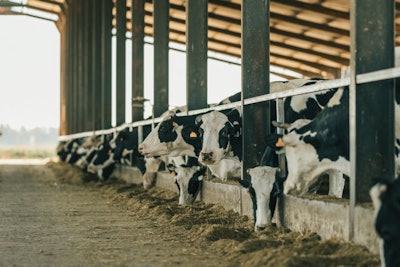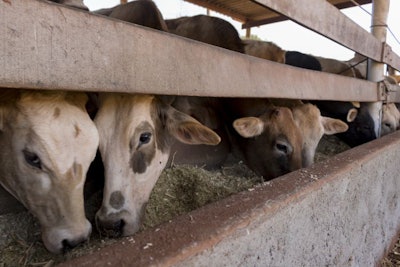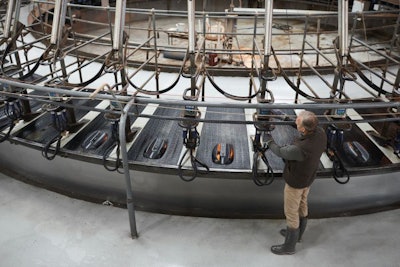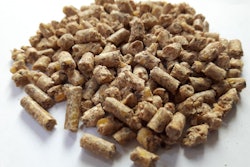
Dairy producers look to maximize profit as they face high input costs, supply chain disruptions and labor shortages.
Like most industries, in 2022, the global dairy industry is facing significantly higher costs along with supply chain disruptions and labor shortages, while also trying to lower emissions and improve sustainability.
The bright spot for dairy producers, experts say, is milk prices that are high enough to offset higher production costs.
While milk prices have increased – and may continue to do so – this has not resulted in greater output, according to Rabobank’s Global Dairy Quarterly report from March.
“Poor forage quality is negatively impacting milk yields in the EU and the U.S.,” the report said. “In some cases, dairy producers are maximizing profit, not production, as they consider escalating feed costs.”
The Russia-Ukraine conflict has affected price and supply of everything from energy to fertilizer and commodities, “which will have a spillover impact on feed costs, feed availability and ultimately on dairy commodity prices and farmgate milk prices,” Rabobank said. Meanwhile, other regions are battling drought and falling yields and acreage.
Maintaining profitability amid high input costs
Feed prices and ingredient availability are “a constant challenge for U.S. dairy farmers,” said Dr. Curtis Harms, DVM, regional director of North America, global business at Diamond V. “They will continue to have to manage this volatility of feed and ingredient prices daily in order to lock in profitability. With feed being the highest cost of an operation, everyone has to be looking for opportunities to manage this segment of their budgets in order to maintain profitability.”
 Feed prices and ingredient availability are a challenge for dairy farmers. (Andre Nery | BigStock.com)
Feed prices and ingredient availability are a challenge for dairy farmers. (Andre Nery | BigStock.com)The rising cost of inputs and the subsequent effect on farm profitability is the top challenge for the entire livestock industry, said Mike Rincker, vice president of research and technical support at DPI Global.
“Given the challenges that our economy is dealing with in every facet, everything is simply costing more and creating greater financial risk and uncertainty,” he said.
Ben Laine, RaboResearch dairy analyst for Rabo AgriFinance, agreed, saying most of the cost pressure for dairy producers comes from higher feed prices. However, he added, now is the time when dairy producers can take advantage of high milk prices.
“For now, milk prices are high enough to offset the higher cost of production dairy producers face,” he said. “Dairy producers should look for opportunities to lock in favorable margins by hedging their milk prices and feed costs as opportunities present themselves.”
Another way producers may look to protect their bottom line is to switch to cheaper feed formulations, but Laine advises against this.
“Dairy producers facing higher feed and ingredient costs this year have to carefully balance temptations to alter rations in a cost-saving effort,” he said. “Maintaining production levels is important to capture the high milk and component prices.”
Instead of looking to cut costs, producers should look for ways to add value, Rincker said.
“So many times when feed costs increase, the first thought that comes to mind involves the removal of any feed additives that may be considered unnecessary or nonessential, but it’s better to have a value-added mentality for these additives during these situations,” he said.
Dairy producers can also maintain profitability by improving efficiency and minimizing waste whenever possible, according to Harms.
“Managing cost in all aspects of the operation without suppressing key revenue centers or health status of the herd” is key, he said.
Effects of supply chain disruptions felt across industry
Meanwhile, supply chain disruptions are affecting everything from ingredient availability to input costs to exports.
“Global supply chain challenges have contributed to the higher cost of production on farms, primarily through higher fertilizer and energy costs,” Laine said. “But higher shipping costs and disruptions also impact dairy exports, which are an increasingly important outlet for U.S. dairy products. While we have managed to move dairy exports fairly well throughout the ongoing disruptions, it has not been without delays, higher costs and missed opportunities that could have provided even greater export value.”
Due to supply chain challenges, dairy exports are expected to slow in 2022, after seeing a 4% growth in 2021, Rabobank said.
“The export growth seen in 2021 is unlikely to be repeated in 2022, as the supply deficit significantly reduces the exportable surplus from the Big 7 export regions,” it said in its quarterly report, referring to the U.S., the EU, New Zealand, Australia, Brazil, Argentina and Uruguay.
Harms said China’s strict two-month COVID-19 lockdown across Shanghai – the location of the world’s busiest container port – “will continue to hamper supply chain disruption, shortages and inflation.”
“There will be continued slowdown worldwide in dairy production causing a negative global milk supply, due to feed imports and higher feed prices,” he said. “Lack of global milk supply should have a positive milk price effect for the U.S., but is dependent on the strength of the U.S. dollar and the supply and demand of dairy products around the world.”
Another effect of global supply chain issues is the shortage and cost increase of palmitic acid and its derivatives; palmitic acid has been widely used for many years as a source of dietary fat to support milk fat production in dairy cows.
“There are many factors driving palmitic acid prices,” said Cecilia Lopez, U.S. ruminant solutions senior manager with Novus International, in a recent press release. “Indonesia, the world’s leading palmitic acid exporter, banned exports of palmitic acid for a time earlier this year; global supply chain issues, and the conflict between Russia and Ukraine are all escalating an already high-cost situation.”
In addition to Indonesian export restrictions, a Malaysian harvest hampered by flooding and labor shortages have sent Malaysia’s palm oil inventory toward historical lows, Rabobank said.
In the U.S., palmitic acid prices have risen 43% over the past 12 months, according to Novus.
Using innovation, technology to achieve better sustainability
Innovations and new technologies to reduce greenhouse gas emissions on dairy farms are helping the industry move toward its ambitious commitments to address climate change and operate more sustainably.
“Sustainability and climate change are definitely talking points amongst stakeholders in the dairy industry, but conversations at the farm level seem to gravitate towards finding that balance between the ‘value’ of sustainability and climate change vs. their impact on one’s profitability,” Rincker said. “This concept is especially true as one considers the implementation of new technologies or innovations reputed to reduce emissions.”
Anaerobic digesters can reduce methane emissions by breaking down manure, wastewater or food waste to produce biogas. Another approach is feed additives that reduce enteric emissions from cattle.
“Feed additives are showing a great deal of promise as they undergo testing and trials and they should begin to gain traction on farms in the coming years,” Laine said.
Emma Song, global technical manager of Wuhan Sunhy Biology Co. Ltd. in China, said there are several feed additives dairy producers can use to reduce emissions or save on costs.
“For example, enzymes could improve the digestibility of dietary nutrients; urease inhibitor could alleviate ammonia intoxication and increase NPN (non-protein nitrogen) utilization,” she said.
All of these advancements have allowed the dairy sector to make “substantial improvements” in sustainability and emissions reduction, Harms said.
According to the U.S. Environmental Protection Agency, U.S. Department of Agriculture Foreign Agricultural Service and American Farm Bureau Federation calculations, the U.S. is producing 51% more milk than in 1990 but has decreased its per unit of milk production emissions by 26%.
The U.S. dairy industry “has seen dramatic increases in milk production per cow, an increase in average cow numbers per farm, more efficient use of resources with better feed efficiency, better forage digestibility, less shrink, less antibiotics, better health, heat abatement and cow comfort which means less maintenance cost per animal,” Harms said. “The dairy industry has made great strides in better manure management and application practices. Additionally, improvement in diet ingredient composition will continue to mitigate enteric emission with additives that are scientifically researched and formulation, with various types of strategies available.”
Addressing labor shortages with automation
The dairy industry is not immune to the labor challenges seen in so many other industries, and it is looking to automation to address them, experts said.
“Nowadays, we can see more automation and artificial intelligence to cope with labor challenges,” Song said.
This includes robotic milkers, manure scrapers and feed scrapers, Rincker said.
 More dairies are using automation and robotics to cope with labor challenges. (SeventyFour | BigStock.com)
More dairies are using automation and robotics to cope with labor challenges. (SeventyFour | BigStock.com)“However, an economics of scale comes into play in regards to the implementation of some of these automation advancements and what size dairy does it make sense to continue with manual labor,” he added. “Given this, there continues to be a big push across agriculture in general to identify and place qualified personnel to meet this labor demand, all while dealing with state and federal labor regulations that continue to evolve.”
Additionally, cow wearable technology can monitor and manage animal health and productivity and aid in labor efficiency.
“Early adaptors of cow wearables are investing to adopt technology that will improve their labor challenges,” Harms said. “As more competition enters this space, it will help drive cost down for more adoption and better profitability for the producers depending on the producer’s needs and jobs to be done.”
Global milk production at a glance
After a decline in production in the first half of 2022, Rabobank said in its Global Dairy Quarterly report from March that it expects a mild recovery in milk production during the second half of 2022 for the “Big 7” exporting regions – the U.S., the EU, New Zealand, Australia, Brazil, Argentina and Uruguay.
However, Rabobank forecasts New Zealand’s milk production for 2021-22 to be down from the previous year by 4%.
“Feed reserves may be tight in some parts of the country through the winter months due to the negative weather impacts on the grain harvest and the use of feed over summer and autumn,” it said in the report.
In Australia, Rabobank said, the outlook for feed is favorable.
“Most dairy farm operators will have a good feed wedge heading into winter and the new season. There will also be a plentiful supply of supplementary feed available but with elevated risk of higher prices,” the report said.
Rabobank also said it expects China’s import requirement to be much lower in 2022 because of ample domestic stocks and growing production. China’s dairy supply continues to grow via domestic production and imports. Rabobank forecasts a 4% increase year over year in milk production for China.














